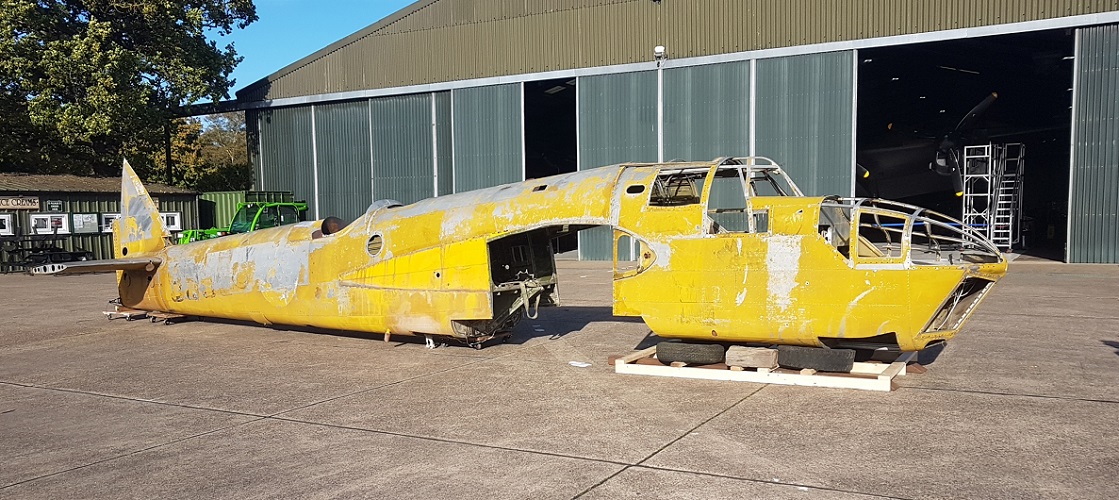
As the Allied Ground and Air Forces faced defeat in May 1940 the RAF had to use its light bomber force in desperate daylight raids against German army bridgeheads in France and the Low Countries. The Blenheim IVs used in these attacks suffered crippling losses. In fact no higher loss, in operations of a similar size, has ever been suffered by the Royal Air Force.
The Blenheim IV, with its redesigned and longer nose, superseded the Blenheim I on the production lines in 1938. The original short nose Blenheim I had been developed from a civil aircraft and was one of the first new high performance monoplanes ordered under RAF Expansion Plans.
After the fighting in France was over Coastal and Bomber Command Blenheim IVs began day and night attacks against German occupied ports and installations in frantic attempts to disrupt their invasion plans. These attacks continued through into 1941 and on 4 July Wg Cdr H.I. Edwards was awarded the Victoria Cross for his part in a daylight bombing attack on Bremen while flying a Blenheim IV.
A number of night fighter conversions were made from early Blenheim Is and later Blenheim IVs but their lack of speed precluded any great success.
Blenheim IVs also served in North Africa and the Far East.
The Blenheim IV was also produced on licence by Fairchild in Canada and was known to Canadians as the Bolingbroke. The Blenheim IV/Bolingbroke was a prolific training aircraft in the British Commonwealth Air Training Plan.
The Lincolnshire Aviation Heritage Centre has two airframes, 9980 and 10073, which will be used to restore a Blenheim IV to stand as a memorial to the early efforts of RAF Bomber Command and their sacrifices against the odds.
Specifications
A ground breaking twin engined light bomber powered by two Bristol Mercury engines with a crew of 3
- Crew 3
- Length 42ft 9in
- Wingspan 56ft 4in
- Height 9ft 10in
- Gross Weight 13,750lb
- Powerplant 2 x Bristol Mercury XV
- Max Speed 288 mph
- Range 1860 miles
- Armament Two .303 Browning machine guns in a Bristol Type B1 dorsal turret
- Bombload 2 x 500lb and 8 x 40lb or 4 x 250lb
The history of 9980 and 10073
The history of Bolingbroke 9980
28th September 1942 Taken on force with number 4 Training Command, Saskatchewan, Canada.
18th March 1943 Became unserviceable at Rockliffe
1st Dec 1944 Allotted to number 3 Training Command for salvage and repair.
23rd March 1945 Awaiting disposal at number 10 Repair Department with only 18:30 airframe hours
Aircraft recovered by Wes Agnew in the 1980's and stored in Manitoba
September 2022 Aircraft purchased by Lincs Aviation Heritage Centre and disassembled by a team from the Centre for the sea voyage to the UK.
History of Bolingbroke 10073
17th February 1943 Taken on force with number 2 Training Command, Winnipeg, Canada.
1st Dec 1944 Allotted to number number 2 Air Command.
7th Feb 1945 In storage at RCAF Station Paulson, Manitoba
The airframe had 643:10 hours when it was struck off charge.
Sold to a local farmer.
Sold to D.Tallichat of Chino, California 1972
2001 Owned by General Patton Army Airfield Groupat Chiriaco, California.
From around 2005/2010, Ownership changed to Pima Air & Space Museum and in storage.
November 2018 Aircraft transferred to Lincs Aviation Heritage Centre.
.jpg)
Explore our other aircraft...
Lancaster
A wonderful taxying example of the elegant Lancaster Bomber, the most famous of all heavy bombers of WW2
Mosquito
The only known NFII and a rare example of this unique and versatile aircraft
Hampden
One of a very few survivors and undergoing a huge restoration to static condition
Proctor
An unsung hero of WW2 this important trainer worked away to help with the Bomber Command aircrew training scheme
B25 Mitchell
American built, RAF operated medium bomber